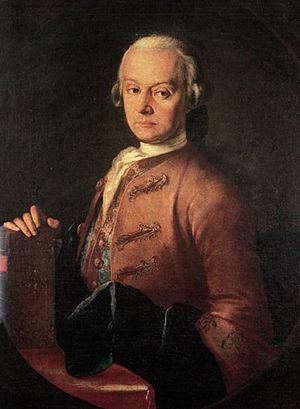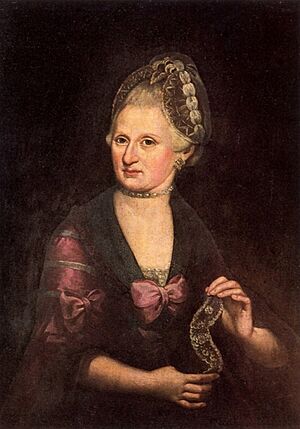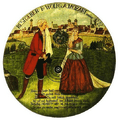Leopold Mozart facts for kids
Johann Georg Leopold Mozart (born November 14, 1719 – died May 28, 1787) was a German composer, violinist, and music teacher. He is most famous today as the father and first teacher of the famous composer Wolfgang Amadeus Mozart. Leopold also wrote an important book about playing the violin, called Versuch einer gründlichen Violinschule, which was published in 1756.
Contents
Life and Music Career
Early Life and Education
Leopold Mozart was born in Augsburg, which was a small independent state in Germany at the time. His father, Johann Georg Mozart, was a bookbinder. From a young age, Leopold sang in a church choir.
He went to a Jesuit school, where he studied subjects like logic, science, and religion. He did very well, graduating with high honors in 1735. While in school, he acted and sang in plays. He also became a skilled violinist and organist. Leopold was also very interested in science, especially microscopes and telescopes.
Even though his parents wanted him to become a Catholic priest, Leopold did not wish to. A friend later said that Leopold was very clever at avoiding this path. After leaving school in Augsburg, he moved to Salzburg in 1737. There, he studied philosophy and law at the Benedictine University. Salzburg was then an independent state, now part of Austria. Leopold lived there for the rest of his life. He earned a Bachelor of Philosophy degree in 1738. However, he was later expelled from the university for not attending classes often enough.
Starting a Music Career
In 1740, Leopold Mozart began his professional music career. He became a violinist and personal assistant to a church official named Johann Baptist. This was also the year he published his first music, six trio sonatas. He even did the copper engraving work for the music himself. He continued to compose, writing several German Passion cantatas, which are pieces of music for voices and instruments.
In 1747, Leopold married Anna Maria Pertl. They had seven children together, but sadly, only two survived past infancy. These two children were:
- Maria Anna Walburga Ignatia, known as Nannerl (born 1751)
- Johann Chrysostomus Wolfgang Theophilus, known as Wolfgang (born 1756)
In 1743, Leopold got a job as a violinist in the court of the Prince-Archbishop of Salzburg. His duties included composing music and teaching violin (and later piano) to the choirboys. He was promoted to second violinist in 1758. In 1763, he became the deputy Kapellmeister, which means he was the assistant music director. He never became the main music director, as others were promoted over him.
Some people disagree about how successful Leopold was as a composer. Some say he was well-known in German-speaking Europe by 1756. Others believe he didn't become a famous composer. However, everyone agrees that Leopold was an excellent teacher.
In 1755, he wrote his famous book, Versuch einer gründlichen Violinschule. This book was a complete guide to playing the violin. It was published in 1756, the same year Wolfgang was born. The book was very popular and was translated into Dutch and French. Today, musicians still use it to learn how music was played in the 1700s. This book helped Leopold become well-known across Europe.
Teaching Nannerl and Wolfgang
Leopold discovered that his two children were very talented in music around 1759. He started giving piano lessons to Nannerl when she was seven. Wolfgang, who was a toddler, immediately began to copy his sister. He quickly learned and made amazing progress with Leopold's teaching.
By 1762, the children were ready to perform concerts. Leopold began taking the family on long concert tours across Europe. They performed for royalty and the public in places like Munich, Vienna, Paris, and London. These trips were very important for the children's musical development. Leopold called his son Wolfgang "the miracle which God let be born in Salzburg."
The tours took up a lot of Leopold's time. Nannerl later said that he stopped teaching violin and composing his own music. He wanted to focus all his time on teaching his two children. After 1762, Leopold mostly revised his older works. By 1771, he stopped composing new music entirely.
The family continued touring into the early 1770s. The last three trips were to Italy, with only Leopold and Wolfgang traveling together. Leopold's long absences from Salzburg during these tours were likely why he was never promoted to the main Kapellmeister position.
Family Life in Salzburg
By 1773, the Mozart family felt they had enough money to move to a bigger home in Salzburg. They moved from the house where the children were born to the Tanzmeisterhaus, or 'Dancing-Master's House'. They had eight rooms, including a large one used for teaching music and for family concerts. They also used it for a fun game called Bölzlschiessen, where they shot airguns at funny paper targets.
Around this time, Leopold spent a lot of effort trying to find a good job for his son Wolfgang. Sadly, his wife, Anna Maria, died in 1778 in Paris. She was with Wolfgang on a trip where he was looking for work.
Relationships with Adult Children
Leopold Mozart is a figure that historians and biographers discuss a lot. They often disagree about his role as a father to his adult children. Some see him as very controlling, while others see him as a caring father trying to guide his son.
Relationship with Nannerl
Wolfgang left home for good in 1781. After that, Leopold lived in Salzburg with just Nannerl and their servants. Nannerl was in her early thirties and had several people who wanted to marry her. She was in love with Franz Armand d'Ippold, but she never married him. It's not known why, but some think Leopold might have stopped the marriage. He liked having Nannerl at home to manage the house.
Nannerl finally married in August 1784, when she was 33. She moved to a small town about six hours away from Salzburg. Leopold continued to help Nannerl from a distance. He did her shopping, helped hire servants, and sent her news from Salzburg. He also helped her with her piano and made sure she got Wolfgang's new music. He encouraged her to stand up to her husband if he was being unfair. Nannerl relied on her father a lot, and his death in 1787 was very hard for her.
Raising Nannerl's Child
In July 1785, Nannerl came to Salzburg to have her first child, a son. When Nannerl returned home, her baby stayed with Leopold. With the help of his servants, Leopold raised his grandson. He often sent letters to Nannerl, usually starting with "Leopoldl is healthy," and giving a full report on the child. Little Leopold stayed with his grandfather until Leopold's death in May 1787. Raising his grandson seemed to make Leopold very happy.
Some historians think Leopold might have hoped to train another musical genius. Others suggest that Nannerl's home situation was not good for raising a child.
Relationship with Wolfgang
Wolfgang left home for good in 1781. He decided to stay in Vienna and work as a freelance musician. He became very famous and successful for a while. This move definitely helped Wolfgang's music develop, as most of his best works were written in Vienna.
Leopold was strongly against Wolfgang's move to Vienna. He wanted Wolfgang to return to Salzburg, and this caused a big family argument. Leopold also strongly opposed Wolfgang's marriage to Constanze Weber in 1782. He only gave his permission late and unwillingly.
In 1785, Leopold visited Wolfgang and Constanze in Vienna. This was when Wolfgang's career was at its peak. Leopold saw his son's success as a performer. On February 12, he heard the famous composer Joseph Haydn praise Wolfgang. Haydn said, "Before God and as an honest man I tell you that your son is the greatest composer known to me either in person or by name: He has taste, and, furthermore, the most profound knowledge of composition." This visit was the last time Leopold saw his son. They continued to write letters, and Wolfgang sometimes sent copies of his music for Leopold and Nannerl to play.
Later in 1785, Leopold took in Nannerl's child without telling Wolfgang. Wolfgang found out the next year from a friend. Wolfgang then wrote to Leopold, asking if he would take care of his own two children while he and Constanze went on a concert tour. Leopold refused, probably with harsh words.
Leopold's health began to fail around this time. He became very ill by April 1787. Wolfgang wrote to him, worried, but did not travel to Salzburg. When Leopold Mozart died on May 28, Wolfgang could not attend the funeral because the journey was too long. Wolfgang was deeply affected by his father's death, despite their disagreements. He wrote to a friend, "I inform you that on returning home today I received the sad news of my most beloved father's death. You can imagine the state I am in."
Compositions
Leopold Mozart's music is often overshadowed by his son Wolfgang's famous works. Leopold willingly put his own career aside to help his son. However, some of his pieces are still popular today. His Cassation in G for Orchestra and Toys, also known as the Toy Symphony, is a well-known example. He also wrote several symphonies and a trumpet concerto.
Leopold Mozart liked to make his music sound very natural. For example, his Jagdsinfonie (Hunting Symphony) uses sounds like shotguns. His Bauernhochzeit (Peasant Wedding) includes sounds of bagpipes, hurdy-gurdy, a dulcimer, whoops, whistles, and pistol shots. His Musikalische Schlittenfahrt (Musical Sleigh Ride) uses bells and whips.
Leopold wrote many pieces of music, but many have been lost. Scholars are still trying to understand the full range and quality of his work. Some of his pieces were mistakenly thought to be by Wolfgang, and vice versa. Much of his surviving music is light and fun, but he also wrote more serious works. These include his Sacramental Litany in D major (1762) and three piano sonatas, all published during his lifetime.
Images for kids
See also
 In Spanish: Leopold Mozart para niños
In Spanish: Leopold Mozart para niños












